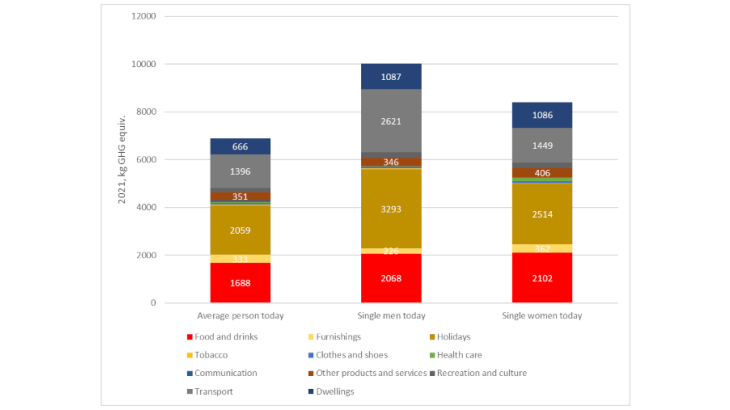Note: Per capita emissions for households are lower on average than those of a single man or woman, mainly because household emissions are pooled among all members of the household, including children.
The work of the IPCC has established that climate change is a major threat. While at first glance the phenomenon might appear to affect all members of the population equally, studies have found gender disparities not just in behaviours that cause greenhouse gas (GHG) emissions, but also in the impacts associated with climate change.
Gender heterogeneity in aggregate greenhouse gas emissions
A first area where the interaction between gender and climate can be seen is in the disparities in behaviours that generate CO2 emissions. Differences in modes of transport, diet or leisure activities have consequences in terms of emissions, and gender is one of the variables that can differentiate individuals’ choices in these matters.
Using consumption-based methods for estimating GHG emissions, it is possible to allocate the emissions linked to the production cycle of goods and services to the final consumer rather than to the producer. This approach notably makes it possible to go beyond a strictly territorial analysis of GHG emissions, and look more closely at heterogeneities in behaviours that generate higher CO2 emissions.
Chart 1 (Carlsson-Kanyama et al., 2021) illustrates one form of heterogeneity in the consumption-related emissions of three types of household in Sweden: an average person (part of a household or single), an average single man and an average single woman. All other things being equal, while the total volume of expenditure for a single man is barely 2% higher than that of a single woman, the man’s consumption categories generate on average 16% more GHG emissions. Hence, single women consume more products and services with a low environmental footprint, whereas single men spend more (70% more) on goods and services with a high GHG intensity, such as petrol or diesel fuel.
This gender-based approach does not mean that men and women make up homogeneous groups, or that gender can explain all observed disparities. However, the above-cited research on Sweden corroborates the findings of other broader studies conducted within the European Union (Räty et al., 2010), or on OECD countries (OECD, 2021). These studies show that gender is a meaningful determinant, alongside other explanatory variables such as place of residence, age or state of health, but that income level often plays a more important role in explaining disparities in emissions within populations.
Differences in environmental behaviours on an individual level and in a professional context
In addition to these differences between expenditure categories, there are also disparities within expenditure items (e.g. food) which are based on differences in individual consumption, such as dietary behaviour. Studies have shown that eating less meat leads to lower emissions. Moreover, there is a correlation between an individual’s choice of diet and their gender: for example, in 2020 in France, 2.2% of the population said they ate no meat and 24% said they were flexitarian (i.e. ate limited amounts of meat without excluding it entirely). Among the vegetarians, 67% of respondents were women, while for flexitarians the proportion was 65% (IFOP, 2021).
Certain studies have also shown that female senior managers are more likely to direct their company towards more sustainable strategies. For example, existing research suggests that women have a higher propensity to protect the environment and pay closer attention to their company’s CSR approach (Liu, 2018). Studies have also found that gender diversity on boards of directors has a positive effect on the consumption of renewable energy (Atif et al., 2021), and, in the case of banks, on the provision of loans to less polluting companies (Gambacorta et al., 2022).
Heightened vulnerability to the physical risks of climate change
While the above-cited works identify heterogeneities between women and men in behaviours contributing to GHG emissions, other studies have highlighted gender disparities in vulnerability to the effects of climate change. The IPCC, for example, has established that these effects are particularly severe for poorer populations, as they are more dependent on natural resources for their livelihoods and less capable of adapting to extreme weather events (IPCC, 2014). Moreover, according to the United Nations, the majority of poorer populations are concentrated in zones where climate risks are particularly severe. Among these populations, women generally have less access to land, education, information and financial resources. This physical vulnerability of poorer populations, combined with socioeconomic factors specific to women in these populations, means that women are disproportionately exposed to the effects of climate change compared with the general population (United Nations, 2022).
The geographical distribution of people in extreme poverty is not the only cause of differences in the effects of climate change on men and women; they are also attributable to disparities in roles and responsibilities within households and communities. The 2004 tsunami in Sri Lanka illustrated how natural disasters can interact with structural trends: 70% of the victims were women, and studies have attributed this to the fact that women were more likely to put the safety of their family first, and were often more vulnerable and less aware of how to protect themselves (Rahiem et al, 2021). According to the United Nations, hurricane Katrina, which struck the United States in 2005, also caused more deaths among women than men (United Nations, 2016). Similarly, the increase in the frequency and intensity of extreme weather events is leading to population displacement, and women are again being disproportionately affected, accounting for 80% of those displaced (United Nations, 2022).
The aim of this analysis is to underline the role that gender can play, alongside other factors such as income or geographical location, in studies related to the environment. By taking into account the interaction between gender and environment, national public policies and international frameworks for action could increase their effectiveness and contribute to the goals of climate justice.
